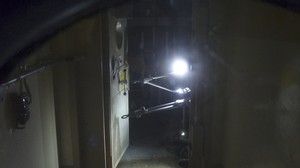Robots Sent Into Nuke Plant
Readings Monday from robots that entered two crippled buildings at Japan's tsunami-flooded nuclear plant for the first time in more than a month displayed a harsh environment still too radioactive for workers to enter.
Nuclear officials said the radiation data for Unit 1 and Unit 3 at the tsunami-flooded Fukushima Dai-ichi plant — collected by U.S.-made robots that look like drafting lamps on treads — do not alter plans for stabilizing the complex by year's end under a "road map" released by the plant operator Sunday.
With the public growing increasingly frustrated at the slow response to the earthquake, tsunami and nuclear crises, parliament grilled Prime Minister Naoto Kan and officials from plant operator Tokyo Electric Power Co.
"You should be bowing your head in apology. You clearly have no leadership at all," Masashi Waki, a lawmaker from the opposition Liberal Democratic Party, shouted at Kan.
"I am sincerely apologizing for what has happened," Kan said, stressing that the government was doing all it could to handle the unprecedented disasters.
TEPCO's president, Masataka Shimizu, looked visibly ill at ease as lawmakers heckled and taunted him.
Workers have not gone inside the two reactor buildings since the first days after the plant's cooling systems were wrecked by the March 11 earthquake and tsunami. Hydrogen explosions in both buildings in the first few days destroyed their roofs and littered them with radioactive debris.
But a pair of robots, called Packbots, haltingly entered the two buildings Sunday and took readings for temperature, pressure and radioactivity. More data must be collected and radioactivity must be further reduced before workers are allowed inside, said Hidehiko Nishiyama of Japan's Nuclear and Industrial Safety Agency.
"It's a harsh environment for humans to work inside," Nishiyama said.
Officials said the radiation findings should not hamper the goal of achieving a cold shutdown of the plant within six to nine months as laid out in a timetable TEPCO announced Sunday. Rather, the new information would help the company in figuring out how to push ahead with the plan.
"We have expected high radioactivity inside the reactor buildings, which was confirmed by data collected by the robot," Chief Cabinet Secretary Yukio Edano said. "Even I had expected high radioactivity in those areas. I'm sure TEPCO and other experts have factored in those figures when they compiled the roadmap."


